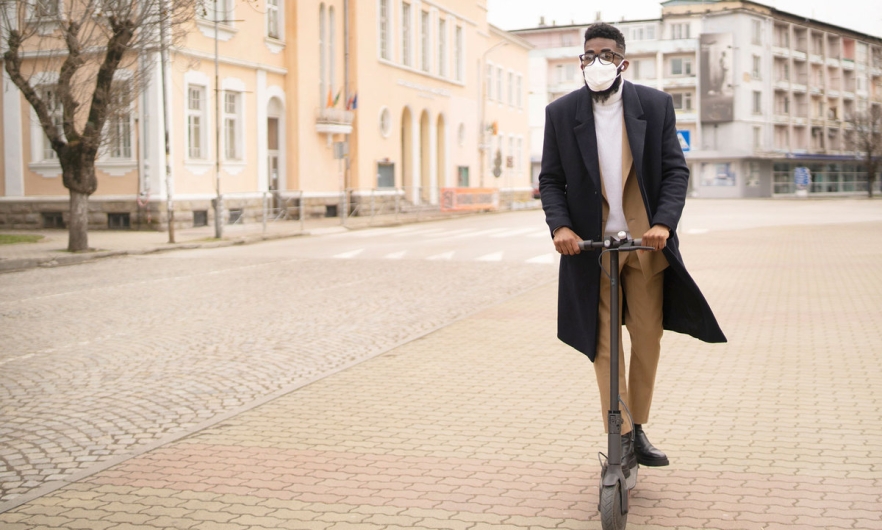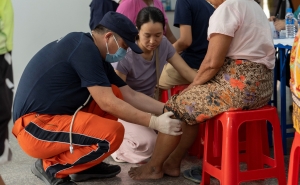E-Scooters and Micromobility Are Potential Public Health Game Changers for Transportation and Equity

Finding parking and navigating through traffic is stressful in most U.S. cities. Though mass transit helps, people who live or work far from bus stops and subway stations can face challenges using it and arriving on time.
Enter e-scooters.
When they emerged in cities like Washington, D.C. and Chicago a few years ago, the sight of people carrying groceries, gym bags, or laptop cases while riding brightly colored scooters must have turned heads. Now, 3,000 scooters dot the streets around Denver, with thousands more available in some of the most populous cities in the country (and the world) including San Francisco and Boston.
The micromobility movement is exploding, not only bringing convenience to city residents—but presenting a chance to address long-standing public health transportation issues that affect health equity.
“Transportation is one of the most underappreciated but significant determinants of our health and well-being,” says Johnathon Ehsani, PhD, MPH, an assistant professor in Health Policy and Management. He says e-scooters have the potential to solve what’s called “first and last mile problems”—referring to the need for a second mode of transportation to reach the buses or subways needed to get to work or other destinations.
“You might live somewhere that’s not walkable to the Metro,” Ehsani says. “But if you had a way to get to the Metro, then you’d be able to get to all kinds of places.” In that way, micromobility could help address persistent social needs such as access to health care, healthy foods, employment, and other important health determinants.
To truly realize the benefits of this new mode of mobility, however, we also need to assess and address risk, says Jeffrey Michael, EdD, distinguished scholar in HPM, emphasizing more research is needed to measure the gains of such devices compared to the safety risks they pose.
In 2014–2018, there were nearly 40,000 injuries related to e-scooter use, according to a 2020 JAMA study, the majority of which involved people ages 18–34. Common injuries included fractures, contusions, and lacerations. Nearly one-third of patients included in the study suffered a head injury—more than double the rate of head injuries bicyclists experience.
The environment in which people ride scooters often contributes to the risk. Half of the participants in a 2018 CDC study on e-scooter-related injuries reported that a surface condition such as a pothole or a crack in the street contributed to their injury.
But our roadways need more than repair, says Ehsani. Because most roadway systems were not designed with e-scooters in mind, many riders are traveling alongside 3,000 pounds of metal traveling at speeds anywhere from 15-30 miles per hour—often without a helmet.
“I’ve ridden a scooter and it is absolutely terrifying,” Ehsani says. “They’re located all around the city [Washington, D.C.] where I live and yet there’s very little in the way of roadway accommodations for them. [Our] roadway systems need to be designed in such a way that accommodates the needs of every single user in a way that tolerates some margin of error.”
This need to update and revolutionize roadway design for new and evolving modes of transportation is exactly what Ehsani and Michael are focusing on now, with their work on Safe Systems.
Though the Biden Administration's recent infrastructure bill shows promise to improve pedestrian and bicycle safety, which would in turn improve micromobility safety, much of the nation’s roadway system is sorely unequipped to handle anything other than the traditional automobile, Michael says.
With funding from the Johns Hopkins Center for Injury Research and Policy, Michael and Ehsani are leading the first national survey of scooter users in the country. Their aim: Provide more data on injuries involving e-scooters to better inform the regulations and policies around this mode of transportation.
Such regulations could be public health game changers if, for example, they require e-scooters and similar transportation modes to be accessible in underserved communities in cities across the country. In Baltimore City, e-scooter companies are required to deploy a certain amount of equipment in areas identified as equity zones. Providing e-scooters in such places can help address “mobility deserts” within our transportation system, Ehsani says.
At the same time, municipalities such as Baltimore are working with micromobility companies to overcome other barriers to accessibility by requiring companies like Lime and Bird to offer reduced-cost riding plans. Both companies also offer payment and access options that don’t require credit cards or smartphones.
These affordability programs are being used, Ehsani says. Rider surveys have shown “substantial overlap” of users in Baltimore’s equity zones and those opting in to the company’s reduced cost programs.
In addition to improving accessibility, scooter companies and cities are also regulating these devices to make them safer for riders and the community at large. GPS-monitoring systems allow companies to set parameters for speed and accessibility depending on the area. Scooters ridden in Baltimore’s Inner Harbor area, for example, are programmed not to exceed 8 miles per hour due to safety concerns for both the rider and pedestrians.
Such regulations could pave the way for future mobility innovation, Michael adds.
“The same kind of tools that we hope to use for automated vehicles are being used right now for micromobility,” Michael says. “We don’t have automated shuttles in the City of Baltimore or anywhere else, but that service will come one day,” he says—thanks in part to valuable lessons brought to us on two wheels.





